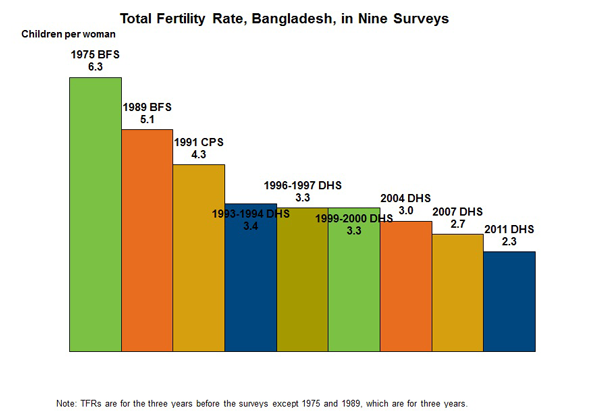The original version of this article, by Carl Haub, appeared on the Population Reference Bureau’s Behind the Numbers blog.The
Bangladesh 2011 Demographic and Health Survey is the ninth demographic survey taken in the country since 1975. Except for a few very small countries and city-states, Bangladesh is the world’s most densely populated country with about 1,100 people per sq. kilometer. The country’s area is about the same as the U.S. state of Arkansas and a bit more than Greece but is home to over 150 million people.
The preliminary 2011 report has just been released and it shows that fertility has continued its decline to a low level. The total fertility rate (TFR) for the three-year period before the survey was 2.3 – 2.0 in urban areas and 2.5 in rural areas. The survey interviewed 17,842 ever-married women ages 12 to 49 and 3,997 ever-married men ages 15 to 54 from July to December 2011. Rural women accounted for two-thirds of those interviewed. From 1975 to 1994, the TFR in Bangladesh was in continuous decline. But the next three surveys showed a tendency for TFR decline to “stall” at a medium level (see graph). Desired family size has greatly decreased. In the survey, 76.2 percent of women with two living children said that they did not wish to have any more children, an additional 5.3 percent had been sterilized, and 1.3 percent said they were incapable of conceiving.
In the survey, 61.2 percent of currently married women said that they were using some form of family planning, a level comparable to developed countries. The use of modern methods was quite high at 52.1 percent. Unlike neighboring India, where female sterilization predominates, the contraceptive pill is the most widely used modern method at 27.2 percent, followed by injectables (11.2 percent), and the male condom (5.5 percent). Contraceptive use has risen steadily in surveys, up from 7.7 percent in 1975. Family planning use has risen despite the fact that fewer women report a visit from a family planning worker, either government or private. Overall, only 15.5 percent reported contact with a home visitor, which has been an important part of the country’s family planning program. The report notes that this may be due to workers deciding to provide services from community clinics for three days a week.
Continue reading on Behind the Numbers.
Sources: MEASURE DHS.
Imaged Credit: Carl Haub/Behind the Numbers.

 A Publication of the Stimson Center.
A Publication of the Stimson Center.




